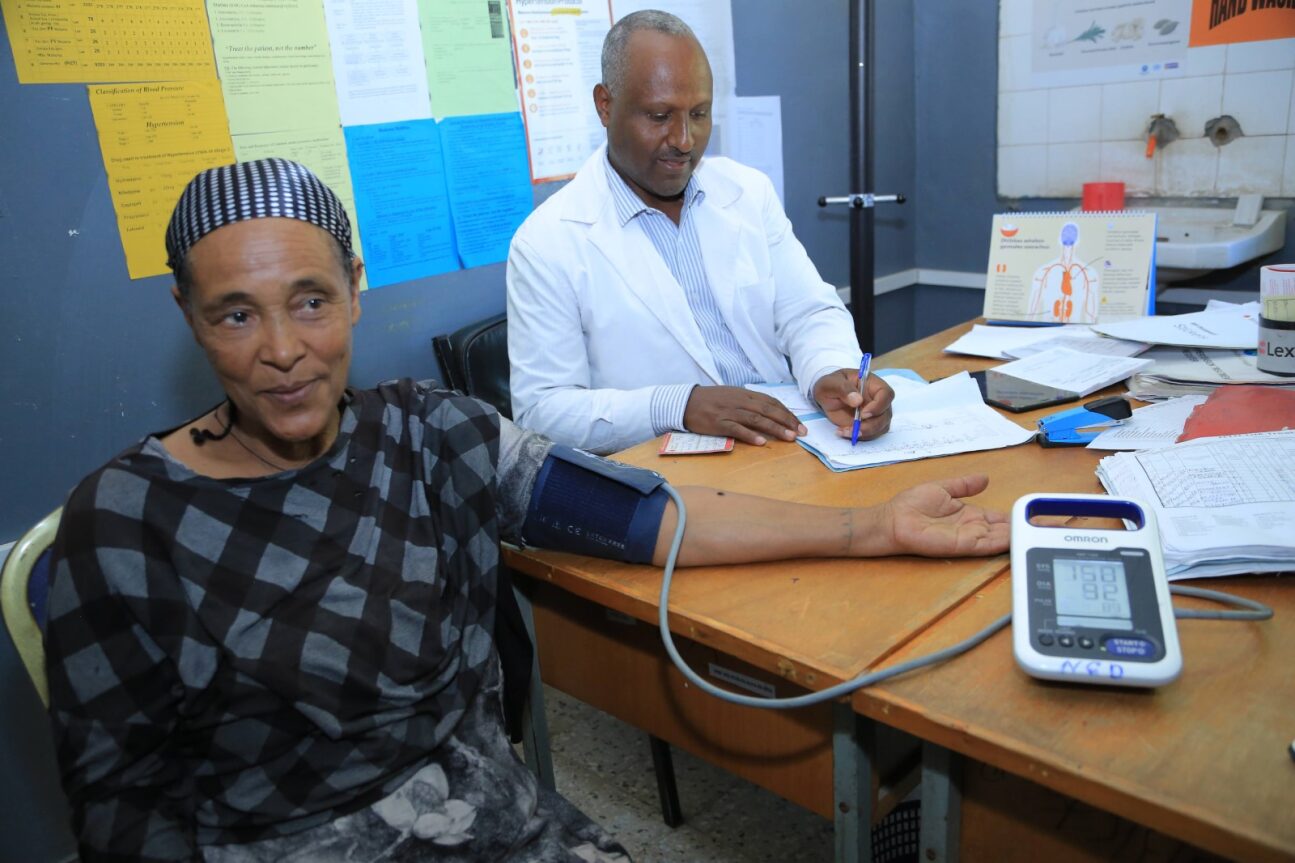According to the World Health Organization (WHO) Global Hypertension Report, high blood pressure is responsible for more than 10 million preventable deaths each year, but only half of people living with hypertension are aware of their condition, and only one in five of them has their high blood pressure controlled by treatment.
In 2017, The CDC Foundation received gift funds from Bloomberg Philanthropies to strengthen cardiovascular health globally as a partner in the Global Hearts Hypertension Control Initiative. The objective of Global Hearts is to implement a standard package of cardiovascular disease prevention practices in low- and middle-income country primary care clinics. To further this objective, CDC Foundation supported experts from multiple countries to assess the costs of implementing the HEARTS hypertension management program recommended by WHO. Together with collaborators from the Centers for Disease Control (CDC), Resolve to Save Live (RTSL), WHO, the Pan American Health Organization (PAHO) and RTI International, the country experts conducted rigorous data collection from primary health care facilities to evaluate the resources needed to scale up this heart-friendly program in their countries.
Dr. Sohel Choudhury, Professor at the Department of Epidemiology and Research, National Heart Foundation Hospital & Research Institute in Dhaka, Bangladesh, oversaw a local team of health economists who estimated that the average medication cost of hypertension treatment using the WHO HEARTS standardized treatment protocols would be approximately $18 per patient per year, while other costs could be substantially reduced by shifting of basic hypertension management tasks from medical officers to non-physician team-members like nurses and community health care providers. Dr. Andrew Moran, Chief of Hypertension Science with RTSL, whose team supported Dr. Choudhury to pilot and then scale up the HEARTS program in Bangladesh, said, “The results have been useful to local advocacy groups in Bangladesh to quantify the government budget required for national scale-up of their national hypertension control program.”
In Mexico, an expert team from PAHO and the National Public Health Institute conducted a similar evaluation in the states of Chiapas and Sonora. The results were published in the Pan-American Journal of Public Health, highlighting the potential for saving nearly 10% of hypertension program costs by using the standardized treatment regimens recommended by the WHO HEARTS program, compared to the usual-care approach. Dr. Pedro Ordunez, Regional Advisor for NCDs and technical leader of HEARTS in the Americas Initiative at the Pan American Health Organization, said, “This project was completed successfully despite coinciding with the COVID-19 pandemic. Indeed, the pandemic revealed the hidden vulnerabilities of patients with uncontrolled hypertension and emphasized the great health and economic value of the new treatment approach introduced by HEARTS Initiative.”
In Ethiopia, Dr. Senait Alemayehu from the Ethiopian Public Health Institute worked in ten health care facilities to collect informative cost data on the Ethiopia Hypertension Control Initiative. She overcame logistical difficulties due to political unrest in the country to successfully complete data collection on treatment costs and approaches, identifying that the hypertension program would cost only $5 per adult primary care user.
Ongoing projects in Thailand and the Philippines are on track to reveal interesting findings. Dr. Chaisiri Angkurawaranon, Head of the WHO Collaborating Center for Prevention and Control of Cardiovascular Disease in Primary Care at the Faculty of Medicine, Chiang Mai University, Thailand, examined all primary facilities in Thailand’s Lampang province in a pilot of the HEARTS standardized treatment approach. He said, “My research team at Chiang Mai University was excited about how the cost analysis of HEARTS identifying areas for efficiency improvements. For example, our work identified a space for cost savings within the current hypertension management approach—specifically, in the area of diagnostic testing practices. WHO and other partners will use this evidence to advocate for a more streamlined and efficient approach, consistent with the WHO HEARTS technical package.”
In the Philippines, Dr. Hilton Lam, Research Professor and Director of the Institute of Health Policy and Development Studies, University of the Philippines, Manila, and his team have focused on comparing the costs of different medication procurement mechanisms. The team has observed that using centralized pooled procurement of hypertension medicines, compared to the usual local procurement, can lower overall program costs and relieve budget pressure on the local government units that are now responsible for financing most health care services in the country.
The partner teams at the CDC Foundation, CDC and RTSL have been excited to contribute toward the goals of cardiovascular disease prevention. Dr. Deliana Kostova, an economist with CDC’s Division of Global Health Protection, emphasized that “All these efforts ultimately feed into the overall objective of strengthening primary care and national health systems. Doing so builds resilient systems and populations that can better withstand pressures from future pandemics and other unexpected setbacks.”
Dr. Renu Garg from Resolve to Save Lives agreed: “Low- and middle-income governments are faced with competing priorities and constrained budgets; what’s more, many governments are not accustomed to paying for life-saving hypertension treatment which is usually lifelong. HEARTS costing gives government decision-makers the evidence they need to support investment in ‘best buy’ interventions that allow their people to live longer and better.”
See also: Global Hearts: Low Cost to Treat High Blood Pressure
